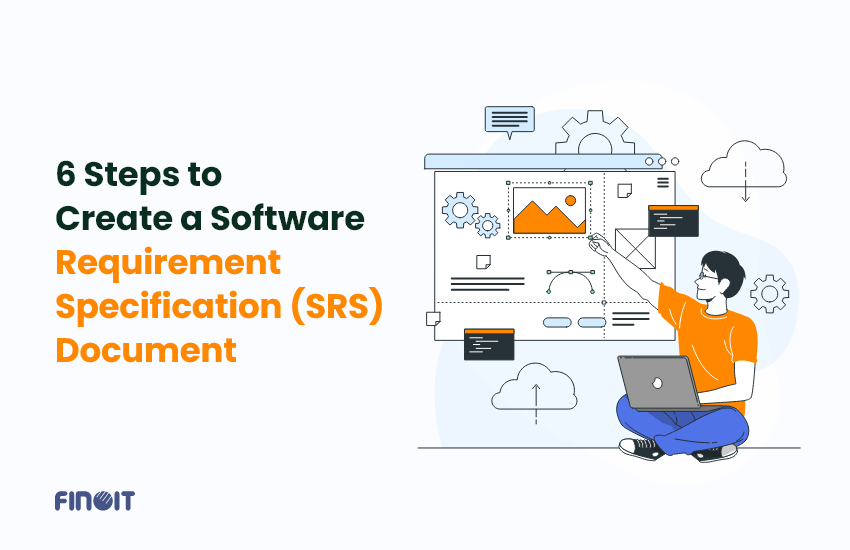6 Steps to Create a Software Requirement Specification (SRS) Document

Have any of your recent projects failed to achieve your anticipated success? You completed the project within the stipulated budget and timeline. You had the support of an efficient team. But still, it didn’t work out. Have you ever pondered over the reason why?
Apart from money, time, and resources, many overlook a factor: a Clear, Concise, and Executable Software Requirement Specification (SRS) document. A study by Project Management Organization reveals that approximately 70% of project failures are attributed to faulty requirements gathering. Additionally, poor requirement gathering for your software project escalates its cost and delays its lifecycle progress.
An SRS is a great way to create, organize, and share your project requirements. But how do you create one? This blog will shed insight on creating a well-defined project requirement.
Step 1# Identify the Stakeholders and Audience of your Project
Identifying stakeholders and your end users is a critical initial step in creating a Software Requirements Specification (SRS). Let us understand how to approach this process in detail:
Map the Landscape:
You can begin by mapping out the project landscape and identifying all parties who are either interested or might be impacted by your software. This includes end-users, clients, project sponsors, developers, testers, system administrators, regulatory bodies, etc.
Diverse Perspectives:
You must understand that all stakeholders will have varied perspectives and interests. While some will prioritize usability, others might focus on security or compliance. Hence, you have to consider both internal and external stakeholders like customers, regulatory bodies, etc.
Hierarchy and Influence:
Try to comprehend the hierarchical structure within the stakeholders’ environment. Identify key decision-makers, influencers, and individuals who can or will be directly impacted by the software. Differentiate between primary stakeholders and secondary stakeholders as well.
Engagement Strategy:
Determine the most effective ways to engage with each stakeholder. Some might prefer one-on-one interviews, while others might respond better to surveys or group workshops.
Step 2# Outline the Goals You Want to Achieve
The success of the SRS largely depends on how well you comprehend and outline the goals of your project. Quoting Yogesh Choudhary, CEO of Finoit Technologies, “Software Requirements Specification is the most important document in the software development process. The more effort you put into it, the bigger the chance of a successful project.”
Here are a few ways to outline your project goals:
Engage in Dialogue:
You can initiate conversations with stakeholders to understand their objectives and expectations regarding the software. Ask open-ended questions to uncover their needs and desired outcomes like: What are you trying to achieve with this project?
Clarify Expectations:
Seek clarity on success from your stakeholder’s perspective. Ask questions like the below to get a clear understanding:
- Do you need any specific functionalities in the software?
- What is the main objective of my software project planning?
- What problems are you expecting the software to solve?
- What would be your Key Performance Indicators for the software?
Prioritize Goals:
Differentiate between the primary and secondary goals of your business requirement. Primary goals are essential for the software’s core functionality, while secondary goals might be desirable but not crucial. Additionally, you can rank goals based on their importance and impact on the project’s success.
Document Goals:
Record these goals systematically. Create a matrix or list in your document to outline each stakeholder’s goals and expectations. Ensure that these goals are aligned with the overall project objectives.
Remain Adaptable:
Stay flexible and adaptable. Stakeholders’ goals and priorities can change based on evolving business needs, market dynamics, or technological advancements.
Step 3# Start Gathering Requirements
Gathering requirements effectively is one of the most pivotal steps for developing a comprehensive Software Requirements Specification (SRS). Here are a few steps to help you gather requirements effectively:
Engage stakeholders through various methods:
If you want to gather insights and requirements regarding the software, it is essential to conduct one-on-one interviews with stakeholders. Encourage them to express their needs, pain points, and expectations using open-ended questions. Additionally, you can organize group workshops with stakeholders from diverse backgrounds. Collaborative exercises can be used during these workshops to gather collective insights. Consider designing and distributing surveys or holding feedback sessions to reach stakeholders who may not be available for interviews or workshops. These methods can help you gather a broader range of opinions.
Gather both functional and non-functional requirements:
Focus on what your software should do. Identify specific actions, features, and capabilities required. For instance, functionalities like user authentication, data storage, or reporting tools fall under this category. Consider non-functional requirements for the types of software projects you are working on, as well, such as performance, security, usability, and compliance. These requirements define how the system should perform and its quality attributes.
Prioritize requirements based on importance and impact:
To achieve project goals and satisfy stakeholders, each requirement’s significance must be evaluated critically and placed in your SRS. Prioritize requirements that impact users more or are critical to the core functionality. To prioritize effectively, you can consider how each requirement affects software performance, usability, and feasibility. Some requirements may be foundational, impacting several other functionalities, while others may be supplementary. Consider all of them before you proceed. For example, a well-defined prioritization matrix could look like:
| Priority | Definition |
| 1 | These are part of core functionality and must have fundamental customer success in Minimum Viable Product (MVP) |
| 2 | They are ideally included in the MVP, as it enables more advanced functionality. |
| 3 | Features with the lowest priority would be excellent to have but not required for MVP |
Since this step is core to defining your SRS, you must actively communicate with stakeholders frequently during this phase to receive clarity and accuracy, which are of utmost importance in requirement gathering. Document requirements meticulously, specifying their source, context, and priority levels. Regularly review and validate gathered requirements with stakeholders to confirm their accuracy and alignment with project objectives. Proceeding with this approach ensures that your resulting SRS adequately represents stakeholder needs and sets a clear path for your software project. You can take the help of a software development project management tool, in this step if required.
Step 4# Define the Software You are Building in Your Requirement Analysis
Critical to defining your software project requirement is describing your product. Who will use it and why? Is it a new product or an add-on to an existing one? Will it integrate with another product? Having clear answers to these questions at the outset will make the product creation process much smoother and more efficient for everyone involved. To accomplish this step you can try the following two approaches
Analyze and Understand the User Needs:
Understanding who will use the product and how is crucial to the SRS writing process. Identifying the different types of users and their specific needs is essential to ensure the product meets their requirements. You must determine whether the users are primary or secondary and their role within their organization. Additionally, it’s crucial to identify what necessities the product must fulfill for them. In some cases, you may also need to consider the purchaser of the product and the end-users’ needs separately. For example, in developing medical and financial-related software, the purchaser and the end user are different, but the needs of both parties must be taken into account.
Scrutinizing Assumptions and Dependencies
You must take some time to identify if the assumptions you are making are true. This will save you from any potential headaches down the line. For example, if you assume you are using current technology in your development project, you can retrospect questions like, Is our framework based on Windows? It is essential to take stock of these technical assumptions to understand any potential issues with your product better. Furthermore, it’s important to note any external factors your project might depend on. Ask yourself questions like: Am I reusing software from a previous project? If so, this new project will rely on that software operating correctly; hence, you should factor that in.
Step 5# Detail Your Specific Software Development Requirements
For your development team to meet the requirements adequately, you must include as much detail as possible. This can feel overwhelming but becomes easier as you break down your requirements into categories. Here is how you can do it:
Functional Requirements
Functional requirements play a crucial role in the development of your product. It’s essential to retrospect on questions like, “Do these requirements enhance my functionality?” or “What function does this provide?” to ensure that your product meets the necessary requirements. In the case of specific industries like medical, finance, or services devices, these functional requirements may have a subset of domain-specific requirements.
External Interface Requirements
These functional requirements are crucial for developing embedded systems, and external interface requirements are a specific type of such requirements. These requirements are essential as they define how your product interacts with other components. Consider several interfaces, such as User, Hardware, Software, Communications, and System Features.
Nonfunctional Requirements
Nonfunctional requirements, which help ensure that a product will work the way users and other stakeholders expect it to, can be just as crucial as functional ones. These may include performance requirements, safety requirements, security requirements, usability requirements, and scalability requirements. The importance of these types of nonfunctional requirements may vary depending on your industry. In industries such as medical devices, life sciences, and automotive, regulations often require tracking and accounting of safety.
Step 6 # Seek Final Approval for the SRS Document
After you have completed the Software Requirements Specification (SRS), the next step is to obtain official approval from the key persons involved in the project. This document is crucial to the success of the project and achieving your business goal as it outlines the requirements for the software system you are building. The SRS serves as a detailed guide that will help you and your team develop the software according to the specifications provided.
To obtain approval, it is essential to present the documentation you have crafted so far clearly and concisely in a way that is easy for stakeholders to understand. It is additionally necessary to explain the benefits that the software system will bring to their business. This will also allow them to ask questions and provide feedback.
Once the stakeholders have reviewed your software project requirement and are satisfied with it, they can approve it, and you and your team can move forward with the development process.
Conclusion
The process does not end here; you should continuously revisit and refine your requirement document as the project progresses, incorporating feedback and lessons learned. It is worth remembering that a well-defined SRS serves as a reference point for the entire software development lifecycle, so investing time and effort into its creation is crucial for the project’s success.
Gathering requirements can be an involved process, but it is indispensable. Following the steps discussed above, you can better handle projects of varying complexity and provide a clear path for everyone involved. This will simplify your project management task and improve the overall outcome.
If you are looking forward for a software product engineering firm to solve your software requirement, get in touch with our experts today!

